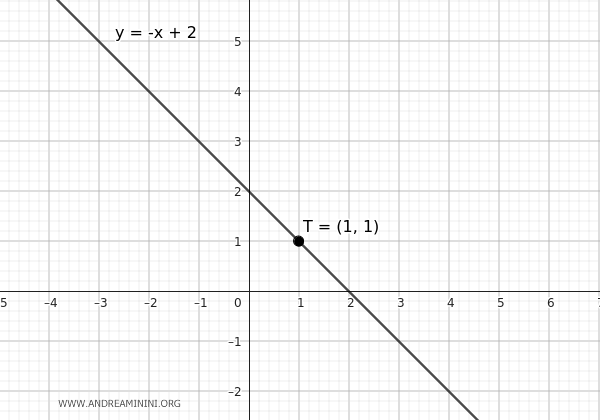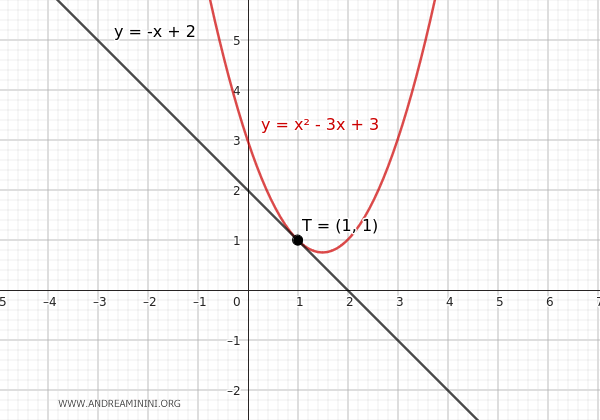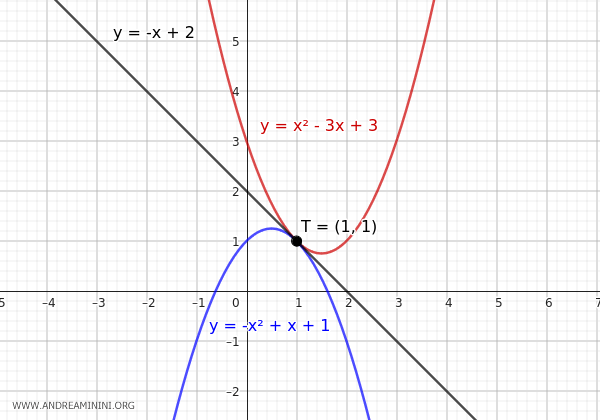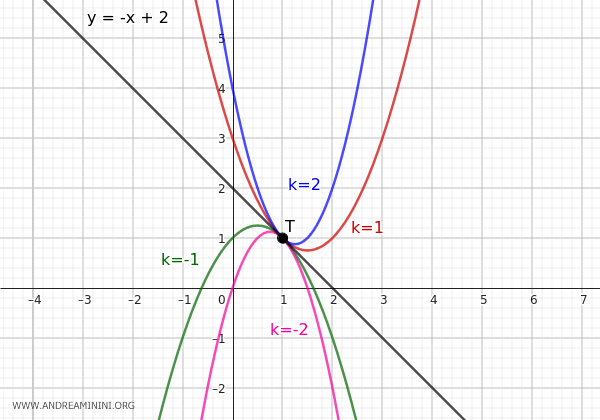A Pencil of Parabolas Tangent to a Line
A pencil of parabolas tangent at the point \( T(x_T;y_T) \) to the line \( r \) with the equation \( y = mx + q \) can be represented by the equation $$ y = mx + q + k (x - x_T)^2 $$
A Practical Example
Let's consider a line \( r \) with the equation
$$ y = -x + 2 $$
Now, take a point \( T \) on this line, \( T(1, 1) \).

The equation for the pencil of parabolas tangent to the line \( r \) at the point \( T \) is:
$$ y = mx + q + k (x - x_T)^2 $$
$$ y = -x + 2 + k (x - 1)^2 $$
Let's construct some parabolas from this pencil using different values of \( k \):
For example, for \( k=1 \) we get the equation
$$ y = -x + 2 + 1 \cdot (x - 1)^2 $$
$$ y = -x + 2 + x^2-2x+1 $$
$$ y = x^2-3x + 3 $$
Here is the graph of the parabola, which is indeed tangent to the line at point T.

Let's take another example with \( k = -1 \)
$$ y = -x + 2 - 1 \cdot (x - 1)^2 $$
$$ y = -x + 2 - x^2 + 2x - 1 $$
$$ y = -x^2 + x + 1 $$
The graph of this parabola is also tangent to the line at point T.

In a similar way, we can obtain all the other infinite parabolas in the pencil.
- For \( k = 1 \) we have the equation \( y = x^2 - 3x + 3 \)
- For \( k = -1 \) we have the equation \( y = -x^2 + x + 1 \)
- For \( k = 2 \) we have the equation \( y = 2x^2 - 5x + 4 \)
All these parabolas are tangent to the line \( y = -x + 2 \) at the point \( T(1, 1) \).

The Proof
To prove that the equation \( y = mx + q + k (x - x_T)^2 \) represents a pencil of parabolas tangent to the line, consider a point \( T(x_T, y_T) \) on the line \( r \):
$$ y = mx + q $$
Since \( T \) lies on the line \( r \), this equation holds true:
$$ y_T = mx_T + q $$
Now consider the equation:
$$ y = mx + q + k (x - x_T)^2 $$
To ensure that all parabolas in the pencil are tangent to the line \( r \) at \( T \), we must verify that the derivative of the parabola at \( T \) equals the slope of the line \( r \), which is \( m \).
Calculate the first derivative of \( y \) with respect to \( x \):
$$ \frac{dy}{dx} = m + 2k(x - x_T) $$
Evaluate the derivative at the point \( T(x_T, y_T) \):
$$ \left. \frac{dy}{dx} \right|_{x = x_T} = m + 2k(x_T - x_T) = m $$
The first derivative of the parabola at point \( T \) equals the slope \( m \) of the line \( r \). This means the line is tangent to the parabola at point \( T \).
Next, let's verify that the point \( T \) lies on the parabola.
Substitute \( x_T \) and \( y_T \) into the equation of the parabola:
$$ y_T = mx_T + q + k(x_T - x_T)^2 = mx_T + q $$
This holds true since \( y_T = mx_T + q \), so the point \( T \) also lies on the parabola.
In conclusion, we have demonstrated that the equation \( y = mx + q + k (x - x_T)^2 \) represents a pencil of parabolas all tangent to the line \( r: y = mx + q \) at the point \( T(x_T, y_T) \).
And so on.
